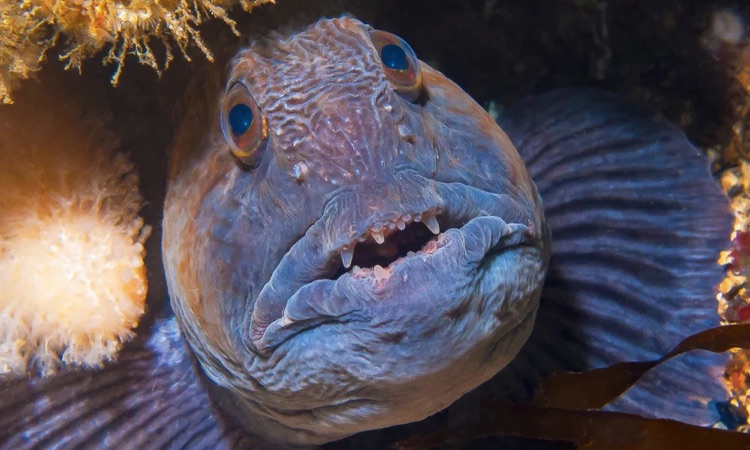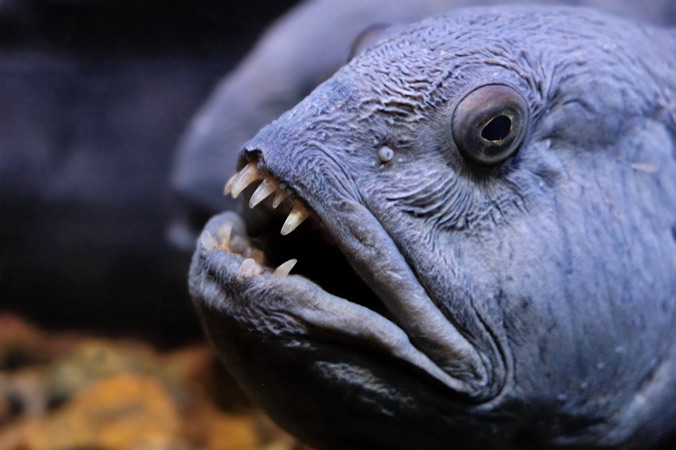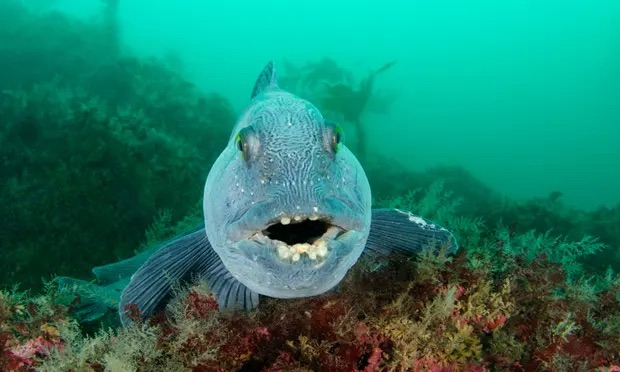The Atlantic wolf fish is a ferocious predator. Its large head, powerful jaws, and sharp canine teeth enable it to hunt effectively for hard-shelled or spiny invertebrates.
The fish are commonly known as “Scotch halibut” or “Scarborough woof” in Britain. They make for a popular meal, often being fried and served with chips. Read on to learn more about this amazing fish.

Appearance
They can grow up to 1.5 m (5 ft) long. The largest Wolf Fish ever caught weighed almost 18 kg (40 lb). They are often considered to be a rather ugly fish.
The Atlantic wolffish is a long, subcylindrical creature with a compressed caudal (tail) portion. Its skin is smooth and slippery, with rudimentary scales that are barely visible. These fish vary in color, but are usually some shade of brown or gray.
The dorsal and ventral fins of this fish are both even and extend the entire length of its body. Its pectorals are large, round, and its pelvic fins have disappeared entirely. The obtuse shape of this creature’s body causes it to swim slowly in a side-to-side motion, much like an eel would.
One of the Atlantic wolffish’s most prominent features is its teeth. In fact, the structure of its teeth is what sets it apart from all other members of the family Anarhichadidae.
Both the lower and upper jaws house four to six fang-like, strong teeth that taper to a point. Behind these conical teeth in the upper jaw are three rows of crushing teeth. Moreover, the central row possesses four pairs of molars while outer rows hold blunted conical teeth.
The lower jaw of the wolffish has two rows of molars behind the primary conical teeth. The throat of the wolffish is also scattered with serrated teeth.
Habitat
The Atlantic wolffish are a type of fish that live in colder water conditions and prefer to stay stationary near the hard ocean floor. They’re commonly seen occupying small spaces like nooks and caves. depths ranging from 20-500 m (66-1,640 ft).
These creatures are found in water that is colder than room temperature but warmer than the freezing point. They have a natural antifreeze in their systems to maintain proper blood circulation, as salt water only freezes below 0 degrees.

Wolf Fish Diet
The Atlantic wolffish are voracious predators, their jaw strength allowing them to crack open and feast upon hard-shelled mollusks, crustaceans, and echinoderms. However, they do not consume other fish.
In their diet, you will often find large whelks, cockles, sea clams, large hermit crabs, starfish, and sea urchins. As a result, they play a key role in controlling the population of predators such as snow crabs and sea urchins that can potentially damage a marine ecosystem.
Reproduction
The way in which Atlantic wolffish fertilize their eggs is what sets them apart from other fish.
Instead of the female fish releasing her eggs into the ocean for the male to fertilize and then leaving, they are internally fertilized. The male wolffish stays with the eggs until they hatch and grow strong enough to be on their own. This is usually four months.
The average width of an Atlantic wolffish egg is 5.5-6 mm, which makes them among the largest fish eggs known.
Their eggs are tinted yellow and opaque, laid on the ocean floor in clumps that stick together loosely. The surrounding area typically consists of seaweed and stones in shoal water. Interestingly, these fish don’t mature until they’re around six years old.

Conservation Status
As compiled by the National Marine Fisheries Service, since 1983 there has been a 95% decline in landings of Atlantic wolffish from U.S. fishing vessels as bycatch, with 64.7 metric tons (mt) being landed in 2007.
The Atlantic wolffish is currently categorized as a Species of Concern under the National Marine Fisheries Service.
The task force recommended the designation of critical habitat to close off both commercial and recreational fishing in those areas, which would overlap with closed areas for other fishing industries.
In addition, they suggested developing catch and release protocols, educational programs for fishermen in the Gulf of Maine area, as well as possession prohibitions.
The Atlantic wolffish population in the Baltic Sea was classified as endangered on the IUCN Red List scale in 2014 by HELCOM.


